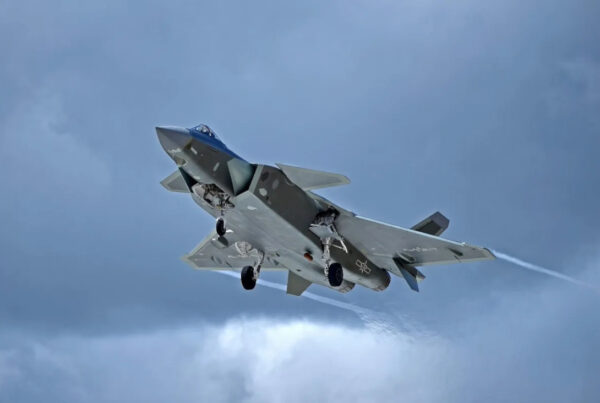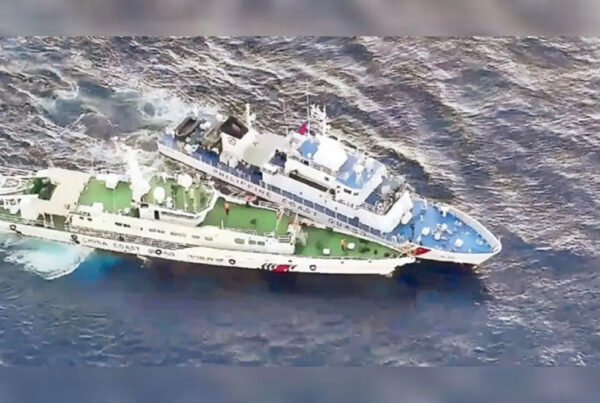This article is Part 1 of the Mackenzie Institute’s China Series.
“Beijing aims to significantly advance military modernization programs in order to establish the capability to fight and win potential regional conflicts (including those related to Taiwan), protects sea lanes of communication (SLOCs), enforce its territorial claims in the South and East China Seas, and defend its national borders.”
– Carl W. Eikenberry (China’s Place in U.S. Foreign Policy)
The June 2015 weeklong visit to the United States (U.S.) by General Fan Changlong, vice-chairman of China’s Central Military Commission, was a part of a years-long effort to build regular dialogue between U.S. and Chinese senior military leadership. The Chinese aim of the visit was in part to defuse growing tensions to avoid any miscalculations in the Pacific region[1] particularly in the East China Sea (ECS) and South China Sea (SCS).
The People’s Republic of China (PRC) continues to use large dredgers[2] to build manmade islands, known as reclamations,[3] in the disputed waters of the South China Seas.[4] This has essentially redrawn the regional map according to China’s Nine-Dash Line claim,[5] a vague boundary first officially published on a map by China’s Nationalist government in 1947 which has since been included in PRC-issued maps, to the consternation of its neighbors. These Chinese activities have been of growing concern, not only to the U.S. but also the Philippines, Vietnam and Japan,[6] in this latter case over the ownership of the Senkakus Islands located in the East China Sea. The PRC also has territorial disputes with North Korea, South Korea, Indonesia, Malaysia and Brunei,[7] whose respective claims are dismissed by Beijing.[8]
China’s maritime claim to large swaths of both seas has elicited a serious response from Washington because the claims involve two American treaty allies – the Philippines and South Korea. Furthermore, the claims potentially undermine the principle of freedom of navigation, a strategic security interest[9] to the U.S. and other trading nations.
At the June 2015 Shangri-La Dialogue, Asia’s premier security conference in Singapore, U.S. Secretary of Defense Ash Carter argued for immediate cessation of land reclamation by those nations in the region and “accused China of being out of step with international rules.”[10]
The legality of these reclaimed man-made islands that reside in disputed waters is under dispute.[11] Moreover, considering the distance from mainland China, these “islands” are not considered by regional nations to be integral to China’s territorial waters. To buttress this political stance, one senior defence official proffered that the U.S. is “considering more military flights and patrols closer to the projects in the South China Sea, to emphasize reclaimed lands are not China’s territorial waters.”[12] Interestingly, attempts to address these maritime claims by the United Nations (U.N.) have essentially been scuppered by the PRC who prefers dealing with these maritime/territorial disputes and their claimants bilaterally rather than through the U.N. or the regional Association of Southeast Asian Nations (ASEAN).
The United Nations Convention on the Law of the Sea (UNCLOS) states that reclaimed features built on low tide elevations or rocks are not able to generate any maritime claims.[13] Low tide elevations are viewed as not capable of generating claims themselves as they are distinct from islands because they are inundated at high tide.[14] As to artificial islands, UNCLOS Article 60 (8) states that: “Artificial islands, installations, and structures do not possess the status of islands. They have no territorial sea of their own, and their presence does not affect the delimitation of the territorial sea, the exclusive economic zone, or the continental shelf.”[15]
During the Singapore symposium, Carter stated that, “Turning an under-water rock into an airfield simply does not afford the rights of sovereignty or permit restrictions on international air or maritime transit.”[16] Moreover, the Chinese attempt of asserting a 22 km territorial sea limit around these reclaimed islands, reefs and shoals are not recognized by the U.S.[17]
These comments were founded upon the recent revelations that U.S. surveillance imagery detected military weapons on one of the newly minted Chinese-made artificial islands located in the Spratly Archipelago. These weapons were described as motorized, i.e. self-propelled artillery pieces that were in range of an island claimed by Vietnam.[18] The artillery pieces were subsequently reported as having been removed.
Regional Concerns
These new islands are large scale Chinese land reclamation projects that are sparking fear across the Asia-Pacific region. The concern is that the Chinese will use such reclamation to push both their territorial and defence claims, as well as facilitate and broaden China’s People’s Liberation Army (PLA) military control and influence over the SCS waters and regional nations.[19]
During Carter’s speech, three points of U.S. policy were driven home: “First, the United States wanted a peaceful resolution of all disputes, an immediate and lasting halt to land reclamation by any claimant, and no further militarization of disputed features. Second, he emphasized that the United States will fly, sail and operate wherever international laws allow – a reference to recent confrontations between Washington and Beijing over freedom of navigation. Third and finally, he noted bluntly that China’s actions in the South China Sea were out of step with international norms and a regional consensus in favor of a non-coercive approach.”[20]
In response, Senior Colonel Zhao Xiaozhuo, deputy director of the Center on China-America Defense Relations at the PLA’s Academy of Military Science, countered that China’s reclamations were “reasonable and justified.”[21]
In a visit to Haiphong, Vietnam, Carter argued that China’s reclamation projects were unprecedented in scale. Moreover, he underlined that other nations, including Vietnam,[22] Malaysia, the Philippines and Taiwan, were undertaking similar but smaller land reclamation projects and they, too, must be stopped. Carter’s concern continues to be focused upon “the prospect of further militarization, as well as the potential for these activities to increase the risk of miscalculation or conflict.”[23]
Geostrategic Importance of Countering Chinese Reclamation – the American Option
One option to reinforce America’s political position, and support regional players, is to politically clarify the U.S. stance that these artificial islands are not sovereign Chinese territory. The persistent presence of U.S. naval ships patrolling the waters to within 12 miles of the reclamation projects reinforces this message. American surveillance aircraft have persisted in flying within the region, prompting China to file a formal protest.[24]
The geostrategic importance represented by the South China Sea reclamations requires a robust approach. These waters are a major maritime economic artery for both regional and global nations and their respective markets.[25] The region accounts for over a third of the global economic output.[26] Therefore China’s aggressive reclamation activities, invasive patrolling and encroachments into waters claimed by other nations, undermine regional and international interests and threaten Asia-Pacific stability. China’s political behaviour, claims and ongoing initiatives ignore the rules and regulations that govern maritime boundaries, and pose a threat to freedom of navigation while usurping any serious opportunities to seek and discuss substantive dispute resolution in good faith. As U.S. Assistant Secretary of State Daniel Russell reportedly stated, “The South China Sea is not about rocks; it’s about rules.”[27] This situation is in itself ambiguous. How does the world’s only superpower deal with a competitive and fast rising China determined to exert its political, economic and military presence both in the region and globally, while ensuring the preservation of their mutually (U.S.-China) beneficial political and economic interests? This is a particularly prickly dilemma as China appears determined to continue its extensive reclamation operations in the South China Sea while concurrently ignoring international law and regional claimants to the waters/territory in question.
China’s unilateral attempt to change the status quo is illegal and flies in the face of international law. These actions must elicit measures that would be costly for the Chinese government. The suggestion of deploying U.S. aircraft and ships to confront, and directly contest PRC claims in the South China Sea would clearly demonstrate that the U.S. government does not recognize Chinese claims.[28]
A more overt initiative would be for Washington to clarify its response to any further Chinese ventures into disputed waters similar to the reassurances given to the Japanese government in their confrontation with China over the Senkakus Island in the ECS. Such a firm political stance, backed up by the U.S. Navy, would reassure friends and allies in the region and clearly warn China as to U.S. policy.[29]
As with any argument, there is a spectrum of counterarguments. Many posit a more sublime approach, particularly as policymakers and observers are fearful that negative fallout could damage America’s extensive and prized economic relationship with China.
Moreover, China must realize that it cannot continue to undertake actions and initiatives that undermine or subvert regional or U.S. interests and not expect a decisive response.[30] It is critical that the U.S. government clearly enunciate those steps that it is fully prepared to support, and undertake, so as to not sully the Obama Administration’s political credibility. This is what happened over Syrian employment of chemical/biological weapons where President Obama said there was ‘a red line’ in their use – U.S. military action pending – but in the end, did nothing.[31]
Experience of the East China Sea
Concerns have been expressed regarding the Chinese reclamations being the prelude to instituting maritime and aerial navigation restrictions or the enforcement of a possible air defence identification zone (ADIZ) over the South China Sea. In 2013, China officially declared such a zone over the Japanese-held islands located in the East China Sea.[32] China contends that its projects constitute sovereign Chinese territory and that the facilities, buildings and airports are built for “public service use and to support fishermen.”[33] According to one report, the disputed Fiery Cross reef[34] has been “transformed from a speck on the map to a man-made island with a military airstrip, which when complete, will be capable of launching Chinese fighter jets over the South China Sea.”[35] This reclamation project is sited near strategic commercial shipping lanes.[36] This is of immense naval significance to the People’s Liberation Army Navy (PLAN) enabling them to regionally dominate the aerial and maritime domains for economic, security and military purposes.
Recent satellite photos have revealed a 3,000 metre runway[37] that can service large civil and military aircraft. The report notes there is a runway “apron for parked planes, two helipads, nine docking piers for ships, ten communications antennae and what may be a radar array. At South Johnson reef, east of Fiery Cross reef, satellite photographs appear to show a port, two helipads and three satellite antennae with radar and weapons installations under construction. There is also a lighthouse, and what may be solar panels and wind turbines.”[38] The facilities clearly satisfy both civilian and military requirements to monitor[39] or interdict sea trade throughout the region, should circumstances necessitate. These reclamation projects are strategically placed “in an area that is crisscrossed by critical shipping lanes.”[40] This is of immense naval significance to the PLAN, enabling it to regionally dominate the aerial and maritime domains for economic, security and military purposes.
Such activities and adamant political stance reinforces the perception that China is intent in dominating the disputed waters of the South China Sea, enabling it to project its air and maritime power throughout one of the busiest and most strategically important maritime shipping routes. Notwithstanding China’s political position, Defence Secretary Carter made it clear that the “United States will fly, sail, and operate wherever international law allows, as U.S. forces do all over the world.” Moreover, he buttressed his remarks that “The United States, its allies, and its partners will exercise ‘the rights of all nations,’ to the fullest.”[41]
Although the U.S. has reportedly declared neutrality on the ongoing territorial disputes in this region it has announced its determination to protect “freedom of navigation,”[42] and intends to send both military aircraft and ships in order to challenge the PRC’s maritime claims.[43]
China’s Military Strategy – White Paper
Since 1945, the U.S. has dominated the global maritime environment and has guaranteed freedom of the seas. The May 2015 Chinese defence policy entitled “China’s Military Strategy,”[44] is most noteworthy as, unlike its eight previous editions, this is the first time that China publicly revealed important aspects of its evolving military strategy. Reportedly, the paper’s title was changed from “China’s National Defense” to the more apt title of “China’s Military Strategy”[45] and unlike previous editions this white paper offers details about the PRC’s strategic intentions, as well as future developments in the Chinese military. One Chinese military official proffered that the “greater transparency of the new white paper was a sign of a more confident China.”[46] Notwithstanding, many of the revelations are not new to political and military observers. The white paper features China’s traditional active defense strategy, which posits that “China would always remain strategically defensive – though perhaps not so at the operational or tactical levels.”[47]
The white paper also notes that “the Chinese military’s primary aim: to prepare itself to fight ‘local wars under conditions of informationization’ (sic) – in other words, regional conflicts in which command, control, communications, intelligence, reconnaissance, and surveillance (C4ISR) would play major roles.”[48] The PLA’s appreciation of these important enablers has not gone unnoticed, but at the same time was hardly a revelation. What is articulated quite clearly in the strategy white paper is that China is focusing its force development in four strategic domains. The PLA intends to boost its cyber warfare capabilities,[49] expand its space program to defend its national interests, even though it is opposed to militarization of space, provide a reliable nuclear force that incorporates a second strike capability and further expand the PLAN, shifting and extending the range of its maritime operations from offshore waters defence to that of open ocean protection.[50]
The white paper argues that China’s growing overseas interests has essentially shifted the national focus from that of a continental land power to that of an emerging maritime power. This realization has led China to prioritize the Navy as an integral and important part of its military modernization program. We are witnessing a dramatic evolution – a sea change in strategic view from that of a powerful continental military to an emerging, and seemingly muscular, maritime power.[51]
China’s Strategic Context and Timing
The timing and publication of this white paper is partly in response to the U.S. Asia Pivot. The document makes references to the U.S. rebalancing strategy and Washington’s effort to enhance its military presence and political influence in the Pacific region.[52] The white paper underlines that other nations could potentially pose a threat to Chinese interests and that specifically Japan and Taiwan, offshore neighbors, external countries and separatist movements, pose regional challenges to the PRC.[53]
China’s Global Engagement
Global economic and political engagement, albeit cautious and limited, has become an integral part of PRC foreign policy. In recent times, the PRC has committed forces to the UN Peacekeeping Mission South Sudan[54] with the aim of resolving the ongoing conflict. Chinese troops are serving under UN command, specifically due to Chinese national interests of ensuring the security of its citizens working in Africa, as well as protecting the substantial Chinese investments.[55] According to reports, the Sudanese Civil War has severed Chinese strategic oil production by one third and the PRC are concerned with protecting its trade with Africa, estimated at $200 billion per year.[56]
Chinese strategic energy interests eclipsed its historical principle of “non-interference” in 2013 when Beijing sent troops to Mali[57] with the intention that the country’s violence did not spill into neighboring Algeria and Libya, whose oil exports were important to China’s continuing economic expansion. In December 2014, China offered Baghdad military support to combat the Islamic State (IS) in the form of air strikes. This offer was subsequently declined.[58] On the home front, PRC officials have engaged with the Taliban on a number of occasions, in part to establish a regional forum for reconciliation in Afghanistan.[59] This border initiative is likely two-fold: to facilitate peace along the Afghan-China border, but also to pre-empt the threat of militant Islamists fomenting problems within China’s Muslim populace.
As with many nations, it is important to appreciate that China’s foreign-policy and military strategy cannot be analyzed in isolation. China’s appetite for natural resources has increased dramatically and is dependent on the importation of a spectrum of strategic resources such as coal, metals, and oil drawn from areas, particularly Africa and the Middle East, which are prone to political turbulence.
China’s strategic interests are in lockstep with China’s economic and political influence in the world. In particular, more than 80% of Beijing’s oil transits one of the world’s global chokepoints in the Strait of Malacca.[60] This channel narrows to less than two miles wide and handles more than 15 million barrels of oil shipments a day.[61] This maritime channel, known as the “Malacca dilemma,”[62] poses the fear that certain powers such as the U.S. could sever China’s strategically vital energy route. Therefore, Chinese foreign-policy must constantly consider the unimpeded access to global consumers and financial markets while concomitantly ensuring an unimpeded flow of raw resources, along with energy in the form of oil and gas, to its home industries.[63]
This strategic situation is not dissimilar from that of other regional actors. For example, it is estimated that 85 to 90% of Japan’s energy supplies flow through the South China Sea,[64] so any existential threat to the maritime trade routes is of strategic concern to Japan, as well as others in the region. Japan’s strategic interest in the South China Sea has brought about joint military exercises with Filipino forces[65] who are also contending with Chinese encroachment upon its claim to islands and the surrounding territorial waters.
China’s Global Engagement: A Two-Edged Sword
On a number of occasions, the U.S. has engaged PRC leadership to pull Chinese political and economic weight internationally. The Obama Administration has complained that China has been a free rider for a number of decades, enjoying the benefits of secure sea routes and freedom of navigation, enabling China’s growing appetite for energy to be secured by U.S. naval dominance. China’s peacekeeping activities in Africa and its participation in antipiracy patrols have been welcomed by the U.S. and, according to Deputy Secretary of State Robert Zoellick, China has become a “responsible stakeholder,” within the international system.[66]
As China’s influence grows and becomes more engaged on the international scene, there can be a downside. As recent events have demonstrated, the PRC will likely throw its political, economic and military weight, particularly in the areas of the East China and South China Seas, challenging many of its less powerful neighbours. Of future concern is that China, once the PLAN becomes globally capable, could undertake maritime operations around the waters of the Middle East[67] where the U.S. could see its freedom to operate freely, challenged by a large and capable Chinese maritime force. As one observer noted, “Granted, that’s not going to happen overnight. Unlike the United States, China doesn’t have formal alliances in the Middle East or air and naval bases nearby – not yet, anyway.”[68] Notwithstanding, China`s naval evolution poses a direct challenge to America’s naval forces in both regional and global terms.
Expanding Requirements and Regional Concerns
In geopolitical terms, China’s requirement for energy and other natural resources has grown dramatically over the recent years. In concert with this dependence is a realization by the PRC that the regions that provide these resources have become increasingly volatile, potentially compromising China’s economic growth and security. Hence, China understands it must be prepared to protect its domestic and foreign economic interests through an uninterrupted supply of resources[69] to the homeland. Hence, the strategic importance of securing its sea lanes of communication (SLOCs), which are the primary maritime routes between ports used for trade, logistics and naval forces, to facilitate and expand China’s economic growth and international trade.
Amongst other issues of concern, the Chinese defence white paper cited concerns that Japan was “overhauling its military and security policies.”[70] Unfortunately, this document does not address the fears and perceptions that abound regionally regarding Chinese reclamations.[71] The white paper notes that Japan’s political and military policies had provoked, “grave concerns among other countries in the region.”[72] This remark may have been an attempt at resurfacing the harsh memories of Japan’s World War II military expansion and occupation of large parts of the region. Notwithstanding, the tensions brought about by China’s reclamation efforts and the dispute over the Diaoyu/Senkaku islands in the East China Sea continue to force these two countries closer.[73]
In addition to these regional concerns, the white paper charges that China’s “offshore neighbors take provocative actions and reinforce their military presence on China’s reefs and islands that they have illegally occupied.”[74] The strategy document identifies these intra-Asian political and territorial issues, while encompassing the interests of the U.S., which appear to be revitalizing not only its military presence, but also its regional alliances.[75] The document further cites that some nations, i.e. the U. S., are “busy meddling in South China Sea affairs; a tiny few maintain constant close-in air and sea surveillance and reconnaissance against China.”[76]
Regional Considerations
China’s supposedly benign reclamation activities have reportedly “filled in enough of the South China Sea to create 2,000 acres of artificial islands in just the last 18 months.”[77]
American and Filipino governments have continued to express their concerns over the large-scale reclamations[78] that persist unabated on at least half a dozen features in the South China Sea. Some of these reclamations could be used for positioning military, naval and aviation assets to intimidate other regional claimants, while reinforcing China’s brazen claims-the traditional 9- dash line (see map) over virtually the entire South China Sea.[79] Such claims also threaten the freedom of maritime navigation in one of the globe’s busiest and economically strategic shipping lanes through which an estimated $5 trillion in shipborne trade transits each year[80] and five times more oil tanker traffic than the Panama Canal.[81] As well, five of the world’s 10 busiest shipping ports are located in this region.[82] Should China ever seek to control access to this region it could easily disrupt the trade and oil shipments to all of East and Southeast Asia, which in turn would paralyze those nations that reside in the region.
In terms of raw resources, the South China Sea represents a region of strategic significance. There exist substantial untapped oil and natural gas reserves, as well as vital fisheries providing food and jobs for millions of people who reside there.[83]
America’s Military Response — Testing China
A June 2015 PRC Foreign Ministry statement said that reclamation projects “do not affect the freedom of navigation and overflight enjoyed by all countries in accordance with international law in the South China Sea.”[84]
Notwithstanding this claim, a U.S. Navy aircraft approached one of the artificial islands and was ordered by the Chinese military to depart the area.[85] A Philippine patrol aircraft in a separate incident was also ordered by the Chinese Navy to depart one of the reclamation sites.[86] These incidents have raised fears that the PRC will announce and enforce a defense identification zone over the South China Sea. This is similar to what occurred in 2013 over a disputed Japanese-held island in the East China Sea.[87]
Some observers have opined that these reclamations will not counter U.S. military superiority in the region, which has been buttressed by a security pact signed by the U.S. and Philippine governments last year, allowing a greater U.S. military presence on Filipino soil, including expanded military bases.[88] Nevertheless, the building of ports, fuel storage depots and what are believed to be two airstrips on reclaimed land[89] would enable the PLA to project military power through the region provoking concerns that their intention is to militarize[90] such reclamations that now reside in disputed maritime territory. Recent history is replete with other similar incidents. In 2012-13 China had a standoff over fishing rights over the triangle of reefs called the Scarborough Shoal. Both parties agreed to withdraw warships after U.S. mediation. China subsequently reneged on the agreement and now the area is fished exclusively by Chinese fishermen and patrolled by PRC vessels.[91] China provoked further tensions with Vietnam in May of 2014, by placing an oil rig near the contested waters of the Paracel Islands 400 km off Vietnam’s coast.[92] Woody Island in the Paracels has been occupied by China since 1956. Satellite images taken March 2015, noted a major expansion of its runway and airport facilities. A 2,920 meter airstrip has been completed, along with a new taxiway, runway aprons with adjacent large buildings under construction on Duncan Island 80 km southwest of Woody seized by China from Vietnam in 1974. Satellite photos clearly show that the size of the island has been increased by over 50% since April 2014.[93] Known as Chenhang Dao in Chinese and Dao Quang Hoa in Vietnamese, the island is home to a military garrison, four radar domes, a concrete plant and a port that has been expanded via a coral cutting and dredging operation.









